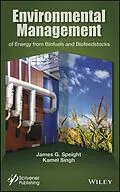The most comprehensive and thorough volume on the environmental aspects of energy from biofuels and biofeedstocks
Biomass is a renewable resource whose utilization has received great attention due to environmental considerations and the increasing demands of energy worldwide. Since the energy crises of the 1970s, many countries have become interested in biomass as a fuel source to expand the development of domestic and renewable energy sources, reduce the environmental impacts of energy production, provide rural prosperity for its poor farmers, and bolster a flat agricultural sector.
This first volume in the Energy and the Environment series discusses the environmental impacts and social concerns of energy production in its various forms, offering comprehensive coverage of the many available biofuels. Starting with a historical overview, Environmental Management of Energy from Biomass and Biofeedstocks:
* Presents a full technological treatment of the processes, engineering, and applications of biofuels and biofeedstocks
* Describes the relevant technologies and their environmental impacts
* Covers the social aspects, economic aspects, and the future of biofuels
* Discusses a variety of biofuels and their possible use and applicability in different countries
Autorentext
James G. Speight is a senior fuel consultant and Visiting
Professor at the University of Trinidad and Tobago and Adjunct
Professor of Chemical and Fuels Engineering at the University of
Utah, USA. He is recognized internationally as an expert in the
characterization, properties, and processing of conventional and
synthetic fuels. He is the author of numerous books and papers, the
editor of two journals in energy, and has won numerous awards and
distinctions.
Kamel Singh is currently Design and Lead Project Manager
at Energy Dynamics Ltd (EDL). He has over twenty years of
industrial experience in the design and construction of process
plants, pressure vessels, storage tanks, pipelines, and offshore
production facilities as well as in welding engineering, quality
control, and maintenance management. He has coauthored over ten
scholarly papers and contributed to three books.
Inhalt
Preface ix
1 Fuels From Biomass 1
1.1 Introduction 1
1.2 The Growth of Biofuels 3
1.2.1 Factors Spurring Growth in the Biofuels Market 4
1.2.2 Challenges to the Wide-Scale Use Of Biofuels 6
1.2.3 History of Biofuels Programs 7
1.2.4 Current Biofuel Production 8
1.3 Conventional Biomass Feedstocks 13
1.3.1 Fuels from Food Fiber and Feed Crops (1st Generation) 13
1.4 Challenges to Conventional Feedstocks 22
1.5 Fuels from Crop Residues, Wood and Dedicated Energy Crops 23
1.5.1 Characteristics of Cellulosic Biomass 24
1.5.2 Biomass Residues and Organic Wastes 26
1.5.3 Wood Residues 27
1.5.4 Crop Residues 28
1.5.5 Energy Crops 30
1.5.6 Micro-Algae 31
1.6 Technologies for Converting Biomass into Liquid Fuels 33
1.6.1 Thermochemical Conversion 33
1.6.2 Biochemical Conversion 35
1.6.3 Emerging Developments in Conversion Technology 36
1.7 The Biorefi nery Concept 38
1.8 Outlook for Cellulosic Liquid Fuels 42
1.9 Biofuels 43
1.9.1 Ethanol from Sugars 43
1.9.2 Ethanol from Starches 44
1.9.3 Fuel Ethanol 44
1.9.4 Lipid-Derived Biofuels 46
References 48
2 Environmental Aspects 53
2.1 Introduction 53
2.2 Greenhouse Gas Emissions 57
2.3 Life Cycle Considerations of Biofuels 59
2.3.1 Feedstock Production, Harvest, Processing, Transport 61
2.4 Refining Feedstocks Into Biofuels 68
2.4.1 Transport of Feedstocks and Fuel 70
2.4.2 Combustion 71
2.4.3 Results of Well-to-Wheel Analyses 73
2.4.4 Reducing the Climate Impact of Biofuels 74
2.5 Impact of Growing Biomass 77
2.5.1 Habitat Destruction 78
2.5.2 Minimizing Land-Use and Impact on Wildlife 81
2.5.3 Impact on Soil Quality 83
2.5.4 Impact on Water Resources 85
2.5.5 Impact on Air Quality 86
References 87
3 Biofuel Policies 93
3.1 Introduction 93
3.2 Regional, National and Local Policies 96
3.2.1 Africa 97
3.2.2 Asia and the Pacific 99
3.2.3 Latin America 102
3.2.4 Europe 105
3.2.5 North America 106
3.3 International Environmental Instruments 108
3.3.1 Greenhouse Gas Emissions 109
3.3.2 Other Emissions 110
3.4 Standards and Certifi cation Schemes 111
3.5 International Trade 115
References 121
4 The Biofuel Life Cycle 125
4.1 Introduction 125
4.2 Energy Balance and Energy Efficiency of Biofuels 126
4.3 Ethanol in SI Engines 132
4.4 Ethanol in CI Engines 134
4.5 Biodiesel Blends 136
4.6 Unblended Biodiesel 138
4.7 Other Biofuels 140
4.7.1 Vegetable Oil and Animal Fats 141
4.7.2 Dimethyl Ether 143
4.7.3 Biomass to Liquid 144
References 149
5 Social Aspects 153
5.1 Introduction 153
5.2 Agricultural and Rural Development 157
5.3 Expanding Markets 159
5.4 Creating Employment 163
5.5 Subsidies 166
5.6 Biofuel Processing 167
5.7 Biofuels for Local Use 169
5.8 Food Versus Fuel Debate 170
5.9 Infrastructure Requirements 174
5.10 Transport, Storage and Delivery 175
5.11 Government Policies and Regulations 178
References 182
6 The Future of Biofuels 187
6.1 Introduction 187
6.2 Next Generation Biofuels 191
6.3 Integrated Refi ning Concepts The Biorefinery 194
6.3.1 The Biorefinery Concept 196
6.3.2 Process Options 197
6.3.3 Anaerobic Digestion 201
6.3.4 Fermentation and Hydrolysis 202
6.3.5 Transesterifi cation...
